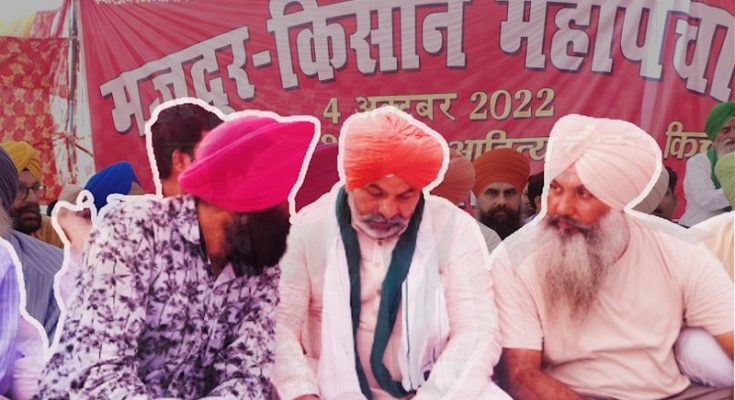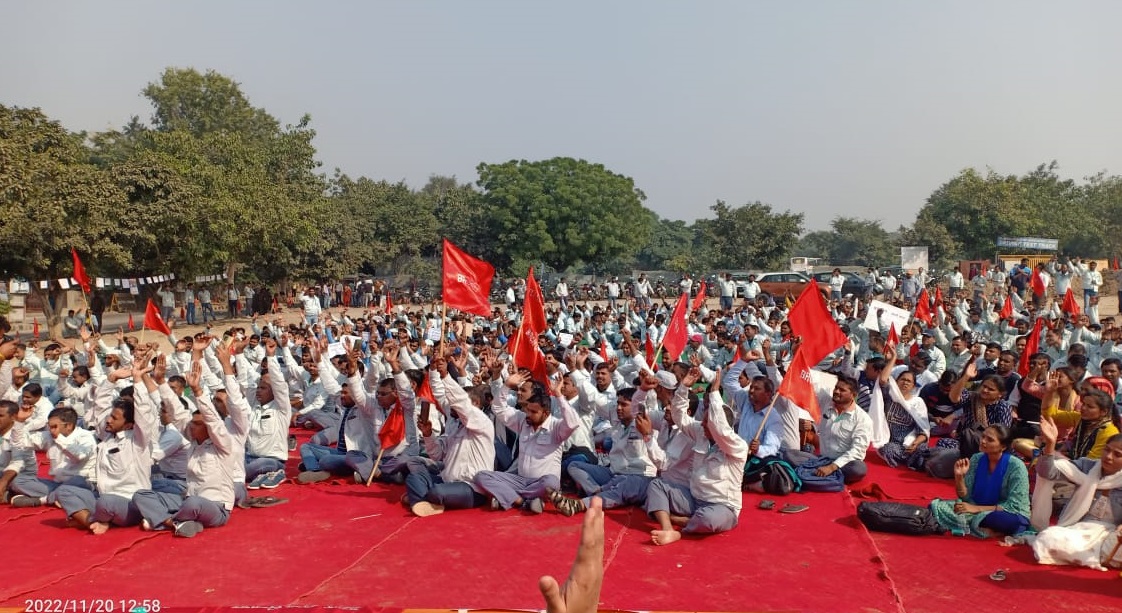By Arpan
In the year 2020-2021 India witnessed one of the largest mass mobilizations in the whole world in contemporary times.
Lakhs of farmers gheraoed different borders of Delhi and continued a 13-month-long heroic struggle against the mighty central government braving all forms of repression by the state machinery.
They finally temporarily withdrew their movements on November 23, 2022, after being victorious on the central demand of repealing the three farm laws passed by the central government.
The farmers’ movement has demonstratively established the role of the peasantry as a powerful resistance block against the anti-people policies of the present regime, as well as established the importance of the organizations like Sanyukt Kishan Morcha or BKU(Ekta-Ugrahan) in public and political life.
From around the time of the historic farmers’ movement, as a form of political mobilization and show of workers-peasant unity, Mazdoor Kishan panchayats got a revival. As a form of political mobilization Mazdoor Kishan panchayats are important for various reasons.
On one hand, it becomes concrete grounds for creating large-scale unity among the masses of working-class and peasantry, on the other hand, it is a living laboratory where various subtle political questions regarding this unity and theoretical understandings around them can actually be tested.
The present article is based on the author’s on-ground experience in two such Mazdoor-Kishan panchayats: one at the gate of Interarch factory, Kichha in Uttarakhand, and one in the Rajeev Chauk, Gurgaon in Haryana.
While the two Majdoor-Kishan panchayats may not necessarily represent all the aspects of workers-peasant politics and pertinent questions around that, the primary intention of this article is not an attempt to answer those questions at any scale, but to initiate conversations around them among the trade union activists, peasant leaders, pro-people intellectuals as well as the broader masses.
- Mazdoor Akrosh Rally in Delhi sends a message of uncompromised struggle of workers : Ground Report
- TUCI demands repeal of 4 labour codes, 3 day dharna at Jantar Mantar concludes
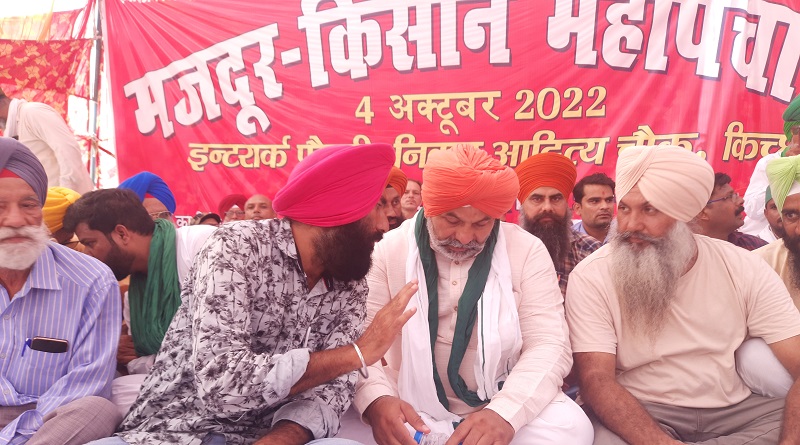
Interarch Majdoor Kishan Mahapanchayet- Kiccha in Uttarakhand
The workers of the Interarch Building Material Pvt. Ltd., Kichha, Uttarakhand are on a continuous struggle against the anti-worker policies of the management since August 16, 2021.
From the last more than a year, the workers and their family members are on a continuous dharna in front of the company gate.
The workers are protesting against the absence of wage increases in the last four years, arbitrary stopping of LDA and bonus, arbitrary termination and suspension of more than 90 workers, fake cases against workers, etc. The company management has repeatedly threatened the union leaders.
In spite of all the repression from the management, the workers have continued the dharna.
Previously, there have been two other Majdoor-Kishan Panchayats on April 26 and October 4 in this long struggle. The current maha panchayat was organized on November 18.
The Maha Panchayat was participated by the farmers’ factions of Sanyukt Kishan Morcha (SKM) and workers’ organization Shramik Sanyukt Morcha (SSM) Sidkul-Panthnagar.
From SKM farmer leader Rakesh Tikait was present. Leaders of Krantikari Kishan Morcha were also present. Workers of the nearby factories in this area like Parle, Nestle, Britania, Bajaj, Voltas, Edwick, JBM, etc also joined with the workers of Interarch in this panchayat.
At this point, a few things need to be said about the general working conditions of the workers in this area. We talked with the unionized workers of Zydus Wellness, Gujrat Ambuja, Bhagavati (Micromax), Delta, etc, and found a general pattern of anti-worker policies like arbitrary termination, low wages, and non-implementation of even the verdicts of the legal battle won by the workers in the court.
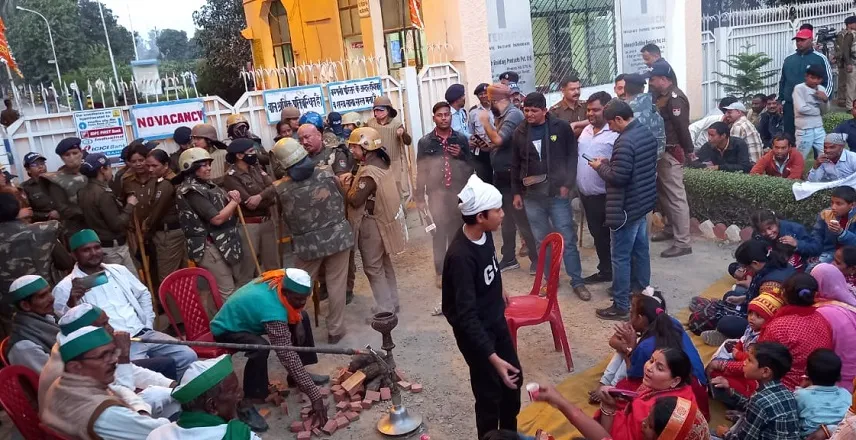
1000+ employees in the Zydus Wellness company were out of a job when the company arbitrarily closed production.
The workers won the case in the High court against the illegal closing of the company and the court verdict was to resolve the problem with the intervention of the labour commission within 30-50 days.
But, despite that, no intervention happened from the labour commissioner. According to workers from Gujrat Ambuja Karmkar Union, Sitaganj 100+ employees have been illegally terminated in their factory during corona times.
Workers from the Delta Employees Union, Panthnagar told that they are fighting for a wage increase and making 35 contractual workers permanent.
Workers from the Bhagvati (Micromax) told that the company is transferring the workers in the name of training and in the last four years, 303 workers have been illegally terminated.
Shramik Sanyukt Morcha is a joint platform for various workers’ unions in the Sidkul-Panthnagar area.
On the day of Majdoor-Kishan panchayat workers blocked the Interarch factory gate and the farmers brought few tractors to help with this process.
Although, so far the company was not ready to accept the demands, after this building up of pressure they agreed to resolve all the disputes within 15 days.
Although the gate blockade was lifted after this, the dharna continued. It was announced that if no resolution comes within 15 days, the gate will be blocked again.
As per the information so far, in the recent talks, the management is not ready to take back any of the terminated employees.
- मानेसर: नए लेबर कोड्स और पूंजीवाद के विरोध में बेलसोनिका यूनियन की मज़दूर किसान पंचायत
- इंटरार्क मज़दूर किसान महांपचायत संपन्न ,किसान संगठनों के दबाव के बाद मज़दूरों से वार्ता को राजी हुआ प्रबंधन
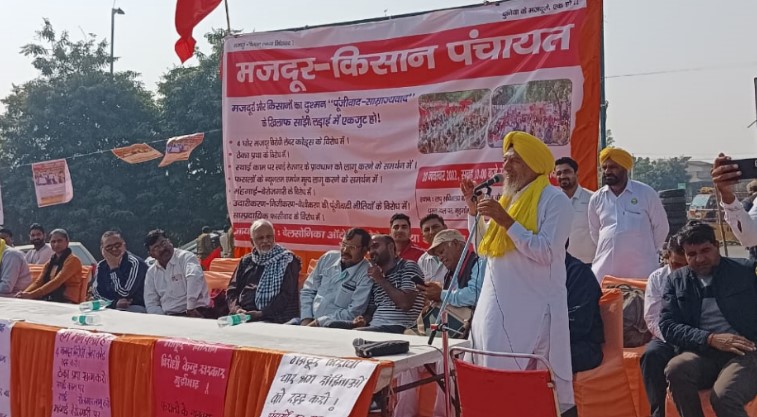
Bellsonica Majdoor Kishan Panchayat
On November 20, the Bellsonica union organized a Majdoor-Kishan Panchayat near the DC office, Rajeev Chauk, Gurgaon (at the plot of SKM dharna during the farmers’ protest). Bellsonica is a parts supplier for the Maruti Company and is located in IMT, Manesar, near Maruti car plant.
The key political points of this Majdoor-Kishan Panchayat were as follows:
- Against 4 anti-worker labour codes
- Against Contractualisation
- For permanent employment in permanent work
- For MSP on the farm produce
- Against the rising cost of living and unemployment
- Against Capitalist policies of Liberalisation- Privatisation- Globalisation
- Against communal fascism
In this panchayat, various workers’ organizations from Gurgaon and Uttarakhand joined. This includes workers from Coparo, Munjal, ISN, and Hitachi. Workers from Interarch, where the Majdoor Kishan maha panchayat happened two days back, were also present.
Among the BKU(Ekta-Ugrahan) leaders Yoginder Ugrahan joined the event with other leaders from his organization. Representatives from SKM were also present.
- आजमगढ़: जमीन अधिग्रहण के खिलाफ किसान-मजदूरों का धरना जारी, प्रदर्शन में शामिल हुए किसान नेता राकेश टिकैत
- उत्तराखंडः मजदूर किसान पंचायत के बाद यूनियन लीडर की गला काट कर हत्या करने की धमकी
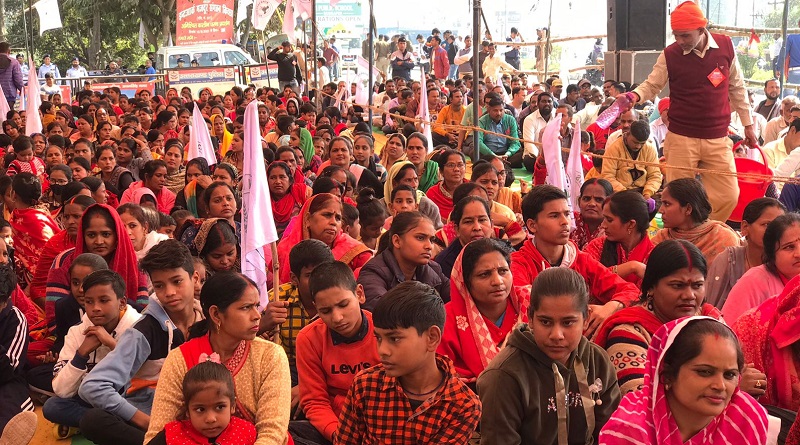
Women’s Participation in both Panchayats
In recent times, there is an inspiring phenomenon of huge women’s participation in larger mass movements. We have seen this in the farmers’ movement, and we have seen it in the movement against CAA-NRC.
This is of particular significance because large part of the country still holds feudal moral values, where women are expected in a secondary role in public and political life.
Women’s participation in both of the panchayats was significant. Especially in the Interarch, a huge number of women and children of the workers’ families participated in the panchayat.
What was different in the two panchayats
Despite the common underlying theme of workers-peasant unity in both the panchayats and broader aspects of a united fight against the common enemy of capitalism, imperialism; there were subtle differences in the two panchayats based on concrete objective situations.
In the Interarch panchayat, the long-drawn struggle made it necessary to focus on achieving immediate factory/area-specific demands.
On the other hand, in Bellsonica panchayat the demands were of the broader working class and not limited to any individual factory.
The relative role of the farmers’ organizations was also different in both cases. In Interarch case, it was more like farmers’ organizations acting as a pressure group to help workers achieve their demands.
In Bellsonica’s case, it was more like a political solidarity of farmers and workers on an equal basis, against the common political enemy. It can be seen from the fact that farmers’ demands for MSP are part of the key points.
Also, privatization and unemployment which are the issues of the broader masses were also part of this panchayat. Workers were at the forefront of this panchayat and systematic problems of Capitalism-Imperialism were also raised.
Future ahead
Despite the successes of the panchayats few things need to be thought about.
While the Majdoor Kishan panchayats clearly portray a unity of leaders of the peasantry and the working class, at the level of ordinary farmers and workers this solidarity was not very apparent.
Ordinary farmers didn’t participate in a large number of these panchayats. How this unity is actually materialized in the movement in the future is something to look for carefully.
While the unity of the working class and the peasantry is important, what role the working class and the peasantry play in such unity is also a crucial point to consider.
The role of the peasantry in the workers-peasant unity must not be as a replacement for militant working class struggle or fulfillment of the lack of strength in the working class movement.
Lessons from history teach us that the working class is the most advanced class in terms of the political movement. One of the primary reasons for this is that the working class doesn’t own the means of production and they have nothing to lose in the political battle against the capital.
Peasant leaders, by themselves, can’t solve the problems of the working class. Also, especially when engaging with the especially landed farmers, which is a property-owning class; the working class must keep in mind that as a property-less class they will be many contradictions, the divergence of specific interests, and class outlook, even while fighting a common enemy.
Any unity of the working class with other classes has thus to be built on the strength of working-class movement itself.
While in recent times there has not been any large workers’ movement with mobilisation of a scale similar to the farmers’ movement, there have been workers’ movements of huge political significance in different sectors.
Large strikes were witnessed in the automobile and transport sectors in various states like Andhrapradesh. In the Foxconn factory, women workers came and blocked the national highway against the bad working conditions.
Anganwadi and Asha workers’ movements saw a huge participation of women workers. Gig and platform workers are erupting in protests. While at present the workers’ movement is not hugely strong, the seeds of huge workers’ movements are already present in all these.
Subscribe to support Workers Unity – Click Here
(Workers can follow Unity’s Facebook, Twitter and YouTube. Click here to subscribe to the Telegram channel. Download the app for easy and direct reading on mobile.)
